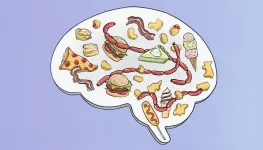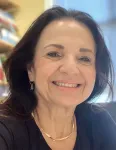(Press-News.org) Scientists don’t call it the “Great Dying” for nothing. About 252 million years ago, upward of 80% of all marine species vanished during the end-Permian mass extinction – the most extreme event of its kind in Earth’s history.
What followed was a mysterious, multimillion-year span that could be called the “Great Dulling,” when marine animal communities looked remarkably alike all over the planet, from the equator to the poles. Researchers have long sought an explanation for this so-called taxonomic homogenization – a scene that played out after other mass extinctions over the past half-billion years.
Now, Stanford researchers have shown that profound environmental change likely provided the means for select survivors of the end-Permian extinction to dramatically expand their ranges. The researchers focused on the marine animal fossil record – the most complete evidence of the extinction’s aftermath – and created a model that predicted how creatures like clams, oysters, snails, and slugs flourished in suddenly warmer, less-oxygenated waters. The findings – published in Science Advances on March 26 – offer insight into life’s recovery not only in bygone eras but also for the present, ongoing mass extinction wrought by human activity.
“For us in the paleobiology field, this model is the equivalent to climate scientists getting computerized climate models to make quantitative predictions of how the world should change based on some simple mathematical representations,” said senior study author Jonathan Payne, the Dorrell William Kirby Professor of Earth and Planetary Sciences in the Stanford Doerr School of Sustainability. “We are now able to study big biogeographic changes of mass extinctions in a new way and get a better sense of why some animal groups made it through while others perished.”
Reconstructing the past
In addition to the fossil record, scientists understand ancient oceans based on naturally occurring chemical markers that reveal past temperatures and environmental conditions. Toward the end of the Permian period, the planet was reeling from cataclysmic volcanic activity in modern-day Siberia, which ushered in intense global warming, oxygen depletion, and ocean acidification that killed most marine organisms 252 million years ago.
But the extinction alone doesn’t explain the bizarre presence of its surviving species – previously constrained to certain specific locations – in every ocean across the globe in the millions of years that followed, known as the earliest Triassic geological period. To convey the surreal concept of taxonomic homogenization on a planetary scale, lead study author Jood Al Aswad, a PhD candidate in Earth and planetary sciences, offered a modern analogy with land animals:
“If someone asked you today where you’d find kangaroos, you’d say Australia,” she says. “But now imagine some major disaster happened, like a giant volcano erupted, and afterward you’re finding kangaroos in great numbers all over the globe – they’re all the way out in Antarctica, they’re hopping by the pyramids in Egypt, and they’re even in Stanford, California.”
Fossils before and after the end-Permian extinction “go from richly diverse communities to almost boringly alike communities, wherever you look,” Payne said. According to the research, the variety of species across different parts of the world was reduced by more than half after the extinction event.
Setting up shop all over
Researchers have debated the cause of these stark fossil record differences for nearly 200 years and, in recent decades, proposed multiple mechanisms for why different locations had remarkably similar inhabitants following the end-Permian extinction.
One hypothesis is “ecological release,” where the die-offs of certain predator and competitor creatures allow one surviving group of organisms to go gangbusters. Another common theory is that the climate changes in ways that produce a favorable environment for the same few organism groups just about everywhere.
The study authors put these hypotheses to the test, using geochemical data that provides information about ancient ocean oxygen levels and temperature conditions to build a climate model for end-Permian environmental change in the oceans.
They then applied data from physiological experiments on living marine invertebrate animals such as clams and snails that are related to the survivors and victims of the Great Dying to populate a climate model with simulated species. These virtual species were able to respond to environmental changes of the end-Permian era based on their ability to survive alterations in temperature and oxygen availability. In this way, the model provided a “physiology-only” evaluation of how species’ geographical distribution would be expected to change if oxygen and temperature were the main drivers of where species could go.
The results show that the hardy clique of mollusks monopolizing the marine fossil record in the Great Dying’s aftermath were indeed well suited for the conditions of the changed world. As a result, the model did not even have to consider ecosystem-level factors such as loss of predators and competitors, which might have also played a secondary role.
“Our study has provided a simple environmental explanation, rather than an ecological one, for why certain survivors of the end-Permian extinction prospered and why homogenization happened on a global scale,” Payne said.
Views into the future
In addition to illuminating the deep past, the new model can also help scientists and policymakers predict and better understand the presently unfolding biodiversity crisis, an impending mass extinction caused by the planet-altering activities of billions of humans.
“The current biodiversity crisis is anticipated to herald changes in ecosystem composition that surpass even those seen in the earliest Triassic, which has been the greatest homogenization event to date,” the study authors wrote.
Al Aswad, Payne, and colleagues are now extending their model to examine other past mass extinctions, such as the end-Cretaceous event that famously wiped out the non-avian dinosaurs.
“Our model offers a great way of studying how animals respond to extreme changes in the environment,” Al Aswad said. “With anthropogenically spurred climate change, there has been some warning that if we continue, then in the future we’re going to see taxonomic homogenization of organisms in modern oceans as well.”
Other Stanford co-authors of the study are Pedro Monarrez (previously a postdoctoral fellow at Stanford and now an assistant professor at Virginia Tech) and Mohamad Bazzi, a current postdoctoral scholar in Payne’s lab. Justin Penn and Curtis Deutsch from Princeton University are also co-authors. The research was supported by funding from the National Science Foundation.
END
How survivors spanned the globe after Earth’s biggest mass extinction
2025-03-26
ELSE PRESS RELEASES FROM THIS DATE:
Even in egalitarian Sweden, a "culture of silence" may prevent university staff and students from reporting sexual harassment
2025-03-26
Even in egalitarian Sweden, a "culture of silence" may prevent university staff and students from reporting sexual harassment, with just an 8.1% reporting rate for students who had experienced either rape or attempted rape.
####
Article URL: https://plos.io/4bW0elh
Article title: What determines the ‘culture of silence’? Disclosing and reporting sexual harassment among university employees and students at a large Swedish public university
Author countries: Sweden
Funding: This work was funded by the Swedish Research Council, ...
Data from the Healthy Minds Study of 140 college campuses in the US suggests that religiousness may be protective against symptoms of depression in students, although less so in sexual minorities
2025-03-26
Data from the Healthy Minds Study of 140 college campuses in the US suggests that religiousness may be protective against symptoms of depression in students, although less so in sexual minorities.
####
Article URL: https://plos.io/3XwiyM6
Article Title: Religiousness, sexual orientation, and depression among emerging adults in U.S. higher education: Findings from the Healthy Minds Study
Author Countries: Spain, United Kingdom, United States
Funding: The authors received no specific funding for this work. END ...
Idaho National Laboratory seeks sponsor for innovation incubator to support technology commercialization
2025-03-26
(IDAHO FALLS, Idaho) – The Idaho National Laboratory (INL) is seeking an industry sponsor to invest $5 million to $10 million in a privately funded innovation incubator. This program will combine the power of a national laboratory with private sector commercialization knowledge to unleash breakthrough innovations by finding and supporting promising startups in the areas of nuclear energy, integrated energy systems, cybersecurity and advanced materials.
The innovation incubator seeks to provide seed-stage startups aligned ...
Ochsner Health celebrates team members recognized as Louisiana State Nurses Association 40 Under 40 honorees
2025-03-26
NEW ORLEANS – Four outstanding Ochsner Health nurses have been named to the Louisiana State Nurses Association’s (LSNA) second annual 40 Under 40 list.
The LSNA 40 Under 40 list celebrates 40 future leaders of nursing in Louisiana who are 40 years of age and under, exemplify dedication to the nursing profession, and demonstrate exceptional leadership qualities.
“We are immensely proud of our Ochsner honorees. This recognition celebrates our nurses who fuel their purpose each day and use their voice to influence the growth of the nursing profession and how we deliver high-quality care to our patients and communities,” said Tiffany Murdock, senior ...
Study explores how time-restricted eating affects weight loss
2025-03-26
Time-restricted eating is the latest craze for people looking to lose weight, but whether it works is still the calorie-burning question.
A new study from the University of Mississippi shows that when healthy adults pair an eight-hour eating window with regular exercise, they lose more fat – without sacrificing lean muscle – compared to exercise alone, according to a study released in the International Journal of Obesity, which is published by the Nature Publishing Group.
“We saw that this did lead to more fat loss and reduced body fat percentage over time when healthy adults were following both exercise with time-restricting ...
Ochsner Health named 2025 Gallup Exceptional Workplace Award winner
2025-03-26
NEW ORLEANS – Ochsner Health, Louisiana’s largest non-profit, academic, multi-specialty, healthcare delivery system, has been awarded the 2025 Gallup Exceptional Workplace Award (GEWA) for employee engagement. This award recognizes the most engaged companies in the world and highlights Ochsner’s continued dedication to setting a standard of excellence in patient care and the workplace.
"Ochsner Health is honored to receive this recognition," said Pete November, chief executive officer, Ochsner Health. "Our commitment to fostering a supportive and dynamic workplace for our team members is directly ...
Researchers have discovered a new mechanism for rapid liver regeneration triggered by glutamate
2025-03-26
Research conducted by the National Cancer Research Centre (CNIO), published today in ‘Nature’, reveals a mechanism in mice that is triggered just minutes after acute liver damage occurs.
This finding opens up avenues for future treatments of serious liver damage to include a diet enriched with the amino acid glutamate.
Glutamate supplementation can promote liver regeneration and benefit patients in recovery following hepatectomy or awaiting a transplant, the authors write in ‘Nature’.
Activating liver regeneration is key to treating diseases that involve severe liver damage, which are becoming increasingly frequent and are associated ...
Scientists discover why obesity takes away the pleasure of eating
2025-03-26
The pleasure we get from eating junk food — the dopamine rush from crunching down on salty, greasy French fries and a luscious burger — is often blamed as the cause of overeating and rising obesity rates in our society.
But a new study by scientists at the University of California, Berkeley, suggests that pleasure in eating, even eating junk food, is key for maintaining a healthy weight in a society that abounds with cheap, high-fat food.
Paradoxically, anecdotal evidence suggests that people with obesity may take less pleasure in eating than those of normal weight. Brain scans of obese individuals ...
How cells respond to stress is more nuanced than previously believed
2025-03-26
CLEVELAND—The body’s cells respond to stress—toxins, mutations, starvation or other assaults—by pausing normal functions to focus on conserving energy, repairing damaged components and boosting defenses.
If the stress is manageable, cells resume normal activity; if not, they self-destruct.
Scientists have believed for decades this response happens as a linear chain of events: sensors in the cell “sound an alarm” and modify a key protein, which then changes a second protein that slows or shuts down the cell’s normal function.
But in a new study published today in the journal Nature, researchers at Case Western Reserve University have discovered a ...
A new method to recycle fluoride from long-lived PFAS chemicals
2025-03-26
UNDER EMBARGO UNTIL: 16:00 GMT / 12 NOON ET WEDNESDAY 26 MARCH 2025
A new method to recycle fluoride from long-lived PFAS chemicals
Images available via the link in the notes section.
Oxford Chemistry researchers have developed a method to destroy fluorine-containing PFAS (sometimes labelled ‘forever chemicals’) while recovering their fluorine content for future use. The results have been published today (26 March 2025) in Nature.
PFAS – which stands for poly- and perfluoroalkylated substances – have been produced in large ...





